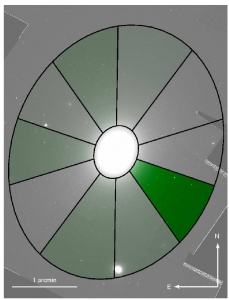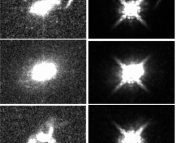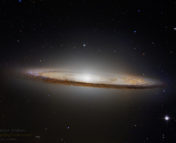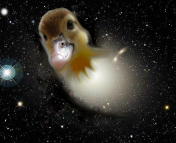Title: Studying the asymmetry of the GC population of NGC 4261
Authors: P. Bonfini, A. Zezas, M. Birkinshaw, D.M. Worrall, G. Fabbiano, E. O’Sullivan, G. Trinchieri, A. Wolter
First Author’s Institution: University of Crete, Greece
Elliptical or “early-type” galaxies are famous for their remarkably smooth, spheroidal distribution of stars (characterized by the De Vaucouleurs law), in stark contrast to the complex, sharp spiral features of late-type galaxies. But not everything is symmetric and uniform in the structure of early-type galaxies; there are well-known cases of asymmetric features such as tidal tails and shells in some ellipticals. Whenever features like this are found, astronomers suspect that gravitational interactions with other galaxies are to blame. The nearby (30 Mpc) elliptical galaxy NGC 4261 does not have these obvious signatures of past disturbances, but Bonfini et al. have found a more subtle clue: an off-balance distribution of globular clusters (GCs) that could have been caused by an interaction with another galaxy in the relatively-recent past.

One of several methods used by Bonfini et al. to identify azimuthal enhancements along the NE/SW axis in the GC distribution of NGC 4261 (from their Figure 9; the background is an I-band image). The density of GCs in each wedge is indicated by the darkness of the green overlay.
GCs are great tools for studying galaxy evolution because they are distinct, bright point-like collections of ~105 stars that were all formed at the same time and place (with some caveats). The authors look for GCs in optical images of NGC 4261 taken in three filters with the HST WFPC2 camera back in 2007-2008. Picking out which point sources on these images are globular clusters rather than Galactic stars or background galaxies is no easy task without spectroscopy, but the authors use a variety of criteria such as color to identify 718 “secure” GCs associated with the galaxy. Their catalog goes as dim as V ~ 25.8 mag, so it’s deep, but not perfect; using the globular cluster luminosity function seen in other galaxies, they estimate that they are missing ~1600 of the very dimmest clusters.
From this catalogue, the authors find evidence for an asymmetry in the two-dimensional spatial distribution of the GCs (see figure at right) around their host galaxy. In the absence of any other effects, GCs should form at random around their central galaxy, but this galaxy’s set of clusters is slightly disturbed. This asymmetry isn’t at all obvious looking at the images by eye, but using Monte Carlo simulations (similar to what Benjamin Nelson discussed), they estimate that this asymmetry is significant at the 99.9% confidence level. However, they are able to model the galaxy starlight without features like tidal tails that would indicate a disturbance of the stellar population.
The authors suggest several scenarios that could have produced the GC asymmetry without significantly affecting the galaxy’s starlight. They favor the idea that a fly-by encounter by another galaxy disturbed the outermost GCs. Another possible scenario, however, is that of a major merger >1 Gyr ago, which could have produced new GCs along a certain axis, donated GCs preferentially along certain orbits, or simply displaced the existing GCs by gravitational interactions. In this scenario, the disturbance in the stellar orbits would have already damped down but the GCs would remain perturbed, perhaps because the GCs orbit farther out and are influenced by the dark matter distribution in a different way. The authors conclude by noting that numerical simulations of the dynamical effect of galaxy interactions on GC populations would aid studies of this kind in the future.
Of course, there would be nothing strange about an elliptical galaxy having undergone a merger. One major paradigm for how we seek to understand galaxy evolution, hierarchical formation, suggests that elliptical galaxies form by the merger of smaller spiral galaxies. Any insight into the interaction history of individual galaxies, such as NGC 4261, is therefore a valuable independent line of evidence that can be used to evaluate this idea. In fact, the observation that most elliptical GC systems, including NGC 4261, have red and blue sub-populations (“bimodal color distributions”) has been interpreted by some as evidence for merger-driven galaxy evolution. The idea is that spiral galaxies like the Milky Way come into the merger with blue, low-metallicity GCs, and then a new population of red GCs form from metal-rich gas during the merger. There are lots of open questions remaining, so you should expect to see GCs continue to be used as an important laboratory for learning about galaxy evolution.




